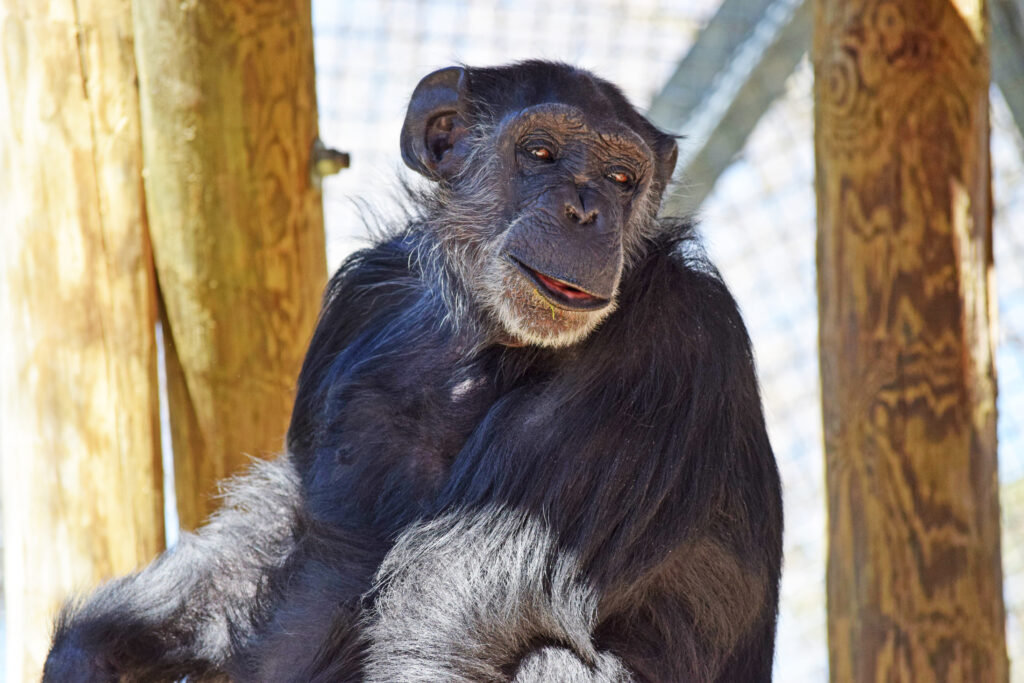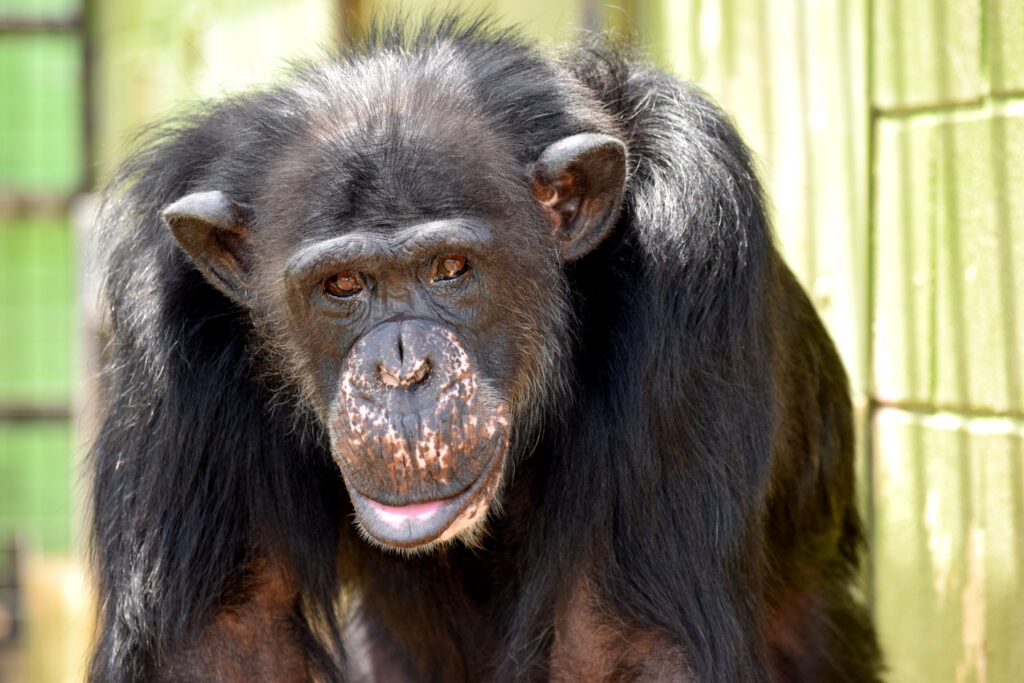Non-Human Primates in Research
Primarily Primates currently houses 33 chimpanzees, many who were used for research at facilities and labs.
These centers include the Laboratory for Experimental Medicine and Surgery in Primates (LEMSIP), White Sands Research Center-Coulston Foundation, Litton Bionetics, Southwest Foundation for Research and Education and Buckshire Corporation. Often operating as a supplier, Buckshire bred chimpanzees and leased animals to research labs.
In some facilities, chimpanzees lived in isolation in standard-sized 5′ x 5′ x 7′ laboratory cages.
The first animal experimentation laboratories opened in the 1860s and 1870 and in 1876, the British Parliament passed the first anti-vivisection law, the Cruelty to Animals Act but research continued in the U.S.
According to the American Anti-Vivisection Society (AVVS), the numbers of nonhuman primates used in research has gradually increased in the last decade and significantly exceeds the numbers of nonhuman primates used when the U.S. Department of Agriculture (USDA) first began to record the numbers of research animals. In 1973, the first year for which records were kept, 42,298 nonhuman primates were used. By 2006, the numbers rose to more than 62,000.

In fact, the number of monkeys used in U.S. biomedical research reached an all-time high in 2017—a staggering 75,000, according to the USDA. The rise could reflect the agency’s expanding investment in these studies—National Institutes of Health (NIH) gave 249 grants in 2017 that supported nonhuman primate research, up from 171 in 2013.
The rising demand for rhesus macaques appears to be driven by researchers studying HIV/AIDS, the brain, Alzheimer’s disease and addiction, according to an NIH report released in 2017.
Primates are increasingly used in pharmaceutical and bioterrorism experiments, and researchers continue to promote the “development of a portfolio of nonhuman primate models for a variety of human diseases and conditions,” says the AVVS. For example, primates are used in experiments related to infectious diseases such as COVID-19, AIDS, malaria, TB, Lyme disease, and Ebola, cardiovascular disease, diabetes, drug abuse, cross-species transplants, toxicology, vaccinations, age-related research, gene therapy, neurosciences and reproductive biology.
Because primates have rich emotional and social lives, they suffer greatly when confined in laboratory settings and used in scientific procedures.
AVVS points out that cynomolgus macaques, also known as crab-eating macaques, make up most nonhuman primates imported for research. Rhesus macaques (Macaca mulatta) are the second most imported primate species. Other highly-imported species include common marmosets, squirrel monkeys, olive baboons, vervet monkeys (also known as grivet or African green monkeys), and night monkeys (also known as owl monkeys). Unfortunately, wild populations of primates across the world are being devastated to supply the research community.
The chimpanzee is the only great ape species used in biomedical research, according to AVVS. Most research involving chimpanzees is invasive, meaning that the projects involve infectious agents, drug testing and/or surgery or biopsy. Because of their similarity to humans, chimpanzee research in particular raises serious ethical and scientific concerns.
Thankfully, some strides have been made in ending the oppression of primates in research. In June 2015, the U.S. Fish and Wildlife Service classified all chimpanzees as endangered, which made it unlawful to conduct invasive research without a permit. Soon after, the NIH said that it would no longer support biomedical research on chimps and planned to retire all NIH-owned chimps to sanctuaries.
However, the NIH continues to fund research on other primates such as rhesus macaques, marmosets, olive baboons and grivet monkeys, all species who also have taken refuge at PPI.
The truth is the AVVS reports that animals have proven to be very poor models for human disease research. Chimpanzee research failed to develop a vaccine to prevent AIDS. And despite millions of animals used in cancer research, roughly 95% of cancer drugs that enter human clinical testing fail despite what the animal experiments may have led researchers to assume.
Thankfully, organ-on-a-chip technology (micro-chips lined by human living cells that closely mimic key physiological functions of body organs) is showing great potential to replace animals in laboratories.
Here are some of the stories of primates formerly used in research who have been cared for at PPI.
Barbara
Barbara came to PPI in May of 2005. Her previous life was spent shuffling between different research centers including LEMSIP and the Buckshire Corporation. When she first arrived, she was afraid of people and her surroundings, but eventually she came out of her shy shell and has settled into her new life very well. Her camaraderie with chimpanzees Shu Shu and Jason is heartwarming. She enjoys strawberries and greeting new people. She also likes to trade old enrichment items for shiny new objects.
Bubba
Bubba came to PPI in May of 2005. Previously he lived most of his life at the Buckshire Corporation. He is now a thriving, friendly chimpanzee. In addition to being one of the most acrobatic chimpanzees at the sanctuary, he absolutely loves shoes. When an enrichment involves shoes, his pan hoots can be heard throughout the sanctuary. He also loves bananas and peppermints.
Siri
Born in 1973, Siri was captured from the wild. Siri was purchased by a private owner and then “donated” to the Sanford Zoo in Florida. She was later sent to the Buckshire Corporation and used for research. Siri was released to Primarily Primates in April 1996. PPI mourned the loss of Siri in April of 2020 after she succumbed to kidney disease. She is missed by care staff and volunteers, as she was always the first in her section of the sanctuary to greet people. She was especially fond of male care staff and showed it by flashing them a gummy smile. Siri liked to follow care staff around the perimeter of her habitat looking for treats that may have been in their pockets. She is also missed by her troop mates Cheetah and Violet. She and Violet would often share a nest. All three especially enjoyed the days when they could forage together for hidden treats that care staff scattered around their enclosure. Her favorite foods were strawberries and romaine lettuce. She liked mushrooms if they had been grilled and seasoned with herbs.

April
It is estimated that April was captured in the wild around 1971 and was privately owned until 1984, when she was leased to the Buckshire corporation. She was used as a breeder for Hepatitis B research. When she arrived at PPI she was thin and shy. Today she is confident, well-adjusted and playful. She loves most food except cactus fruit and her favorite enrichment activity is foraging.
